ECON111 Assignment: Microeconomic Principles and Operation Barga
VerifiedAdded on 2022/10/17
|11
|2737
|12
Homework Assignment
AI Summary
This assignment delves into microeconomic principles, utilizing the historical context of Operation Barga in West Bengal, India. It begins by explaining the economic incentive schemes and the impact of Operation Barga on sharecroppers' productivity and income. The assignment then explores the ethical dimensions of the policy, analyzing it through consequentialist and deontological ethical frameworks. Furthermore, it examines the concepts of Pareto improvement and Pareto efficiency, evaluating the reallocation of resources between landowners and farmers. Finally, the assignment presents a model of an independent farmer and then a sharecropper, illustrating the impact of sharecropping on production possibilities and optimal choices using indifference curves and production possibility frontiers, demonstrating how the economic landscape changes for farmers under different conditions. The assignment aims to provide a comprehensive understanding of microeconomic concepts through a real-world case study.
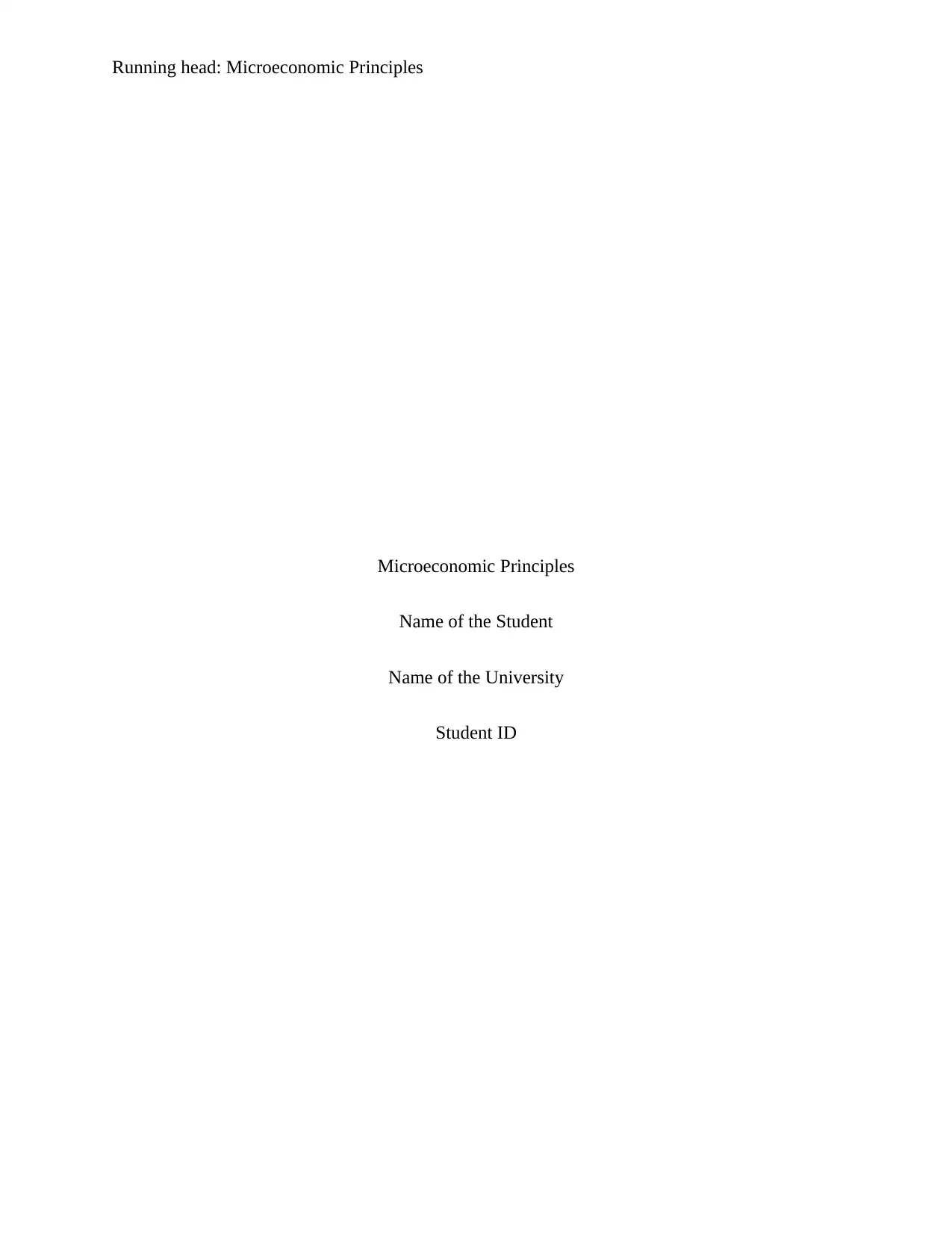
Running head: Microeconomic Principles
Microeconomic Principles
Name of the Student
Name of the University
Student ID
Microeconomic Principles
Name of the Student
Name of the University
Student ID
Secure Best Marks with AI Grader
Need help grading? Try our AI Grader for instant feedback on your assignments.
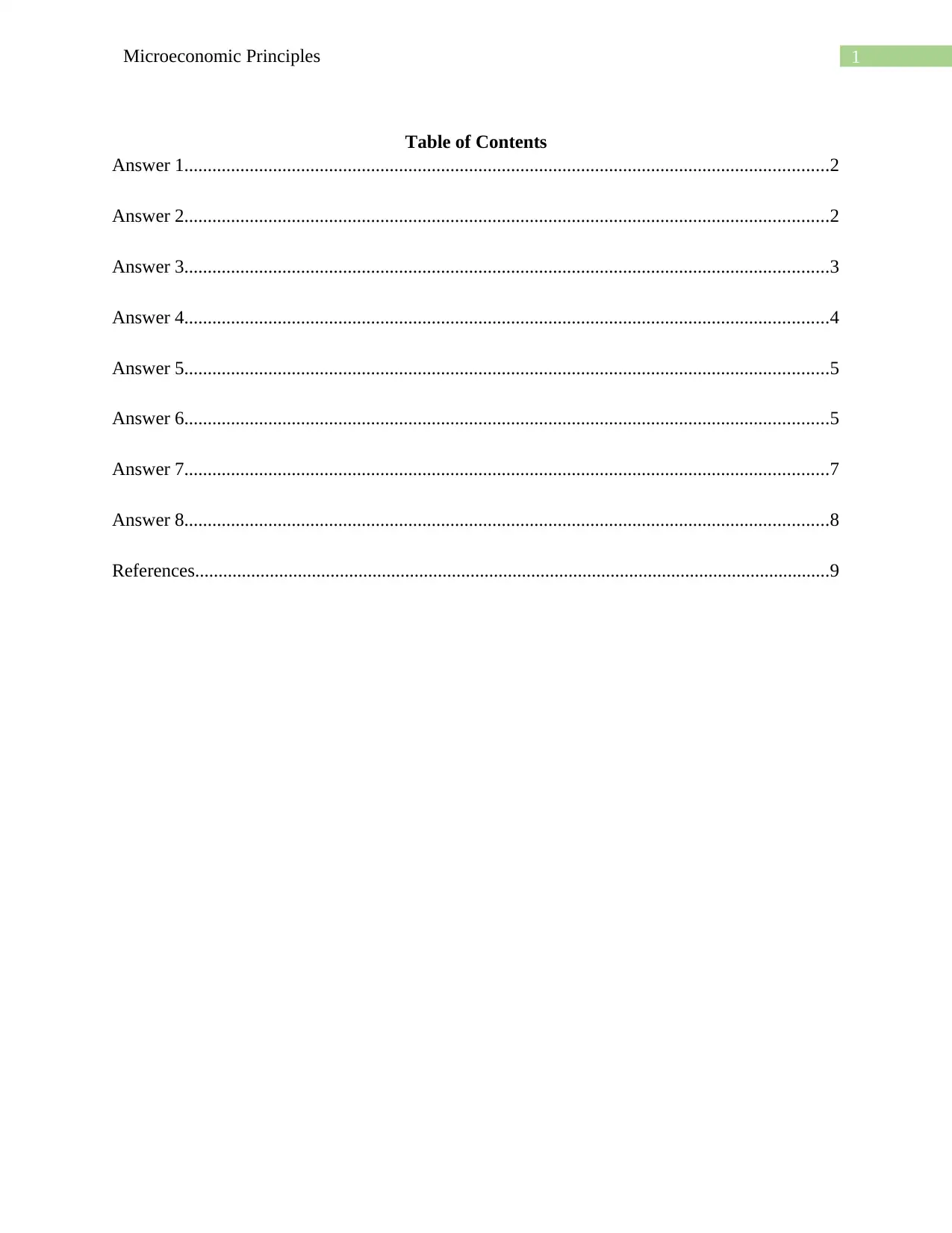
1Microeconomic Principles
Table of Contents
Answer 1..........................................................................................................................................2
Answer 2..........................................................................................................................................2
Answer 3..........................................................................................................................................3
Answer 4..........................................................................................................................................4
Answer 5..........................................................................................................................................5
Answer 6..........................................................................................................................................5
Answer 7..........................................................................................................................................7
Answer 8..........................................................................................................................................8
References........................................................................................................................................9
Table of Contents
Answer 1..........................................................................................................................................2
Answer 2..........................................................................................................................................2
Answer 3..........................................................................................................................................3
Answer 4..........................................................................................................................................4
Answer 5..........................................................................................................................................5
Answer 6..........................................................................................................................................5
Answer 7..........................................................................................................................................7
Answer 8..........................................................................................................................................8
References........................................................................................................................................9
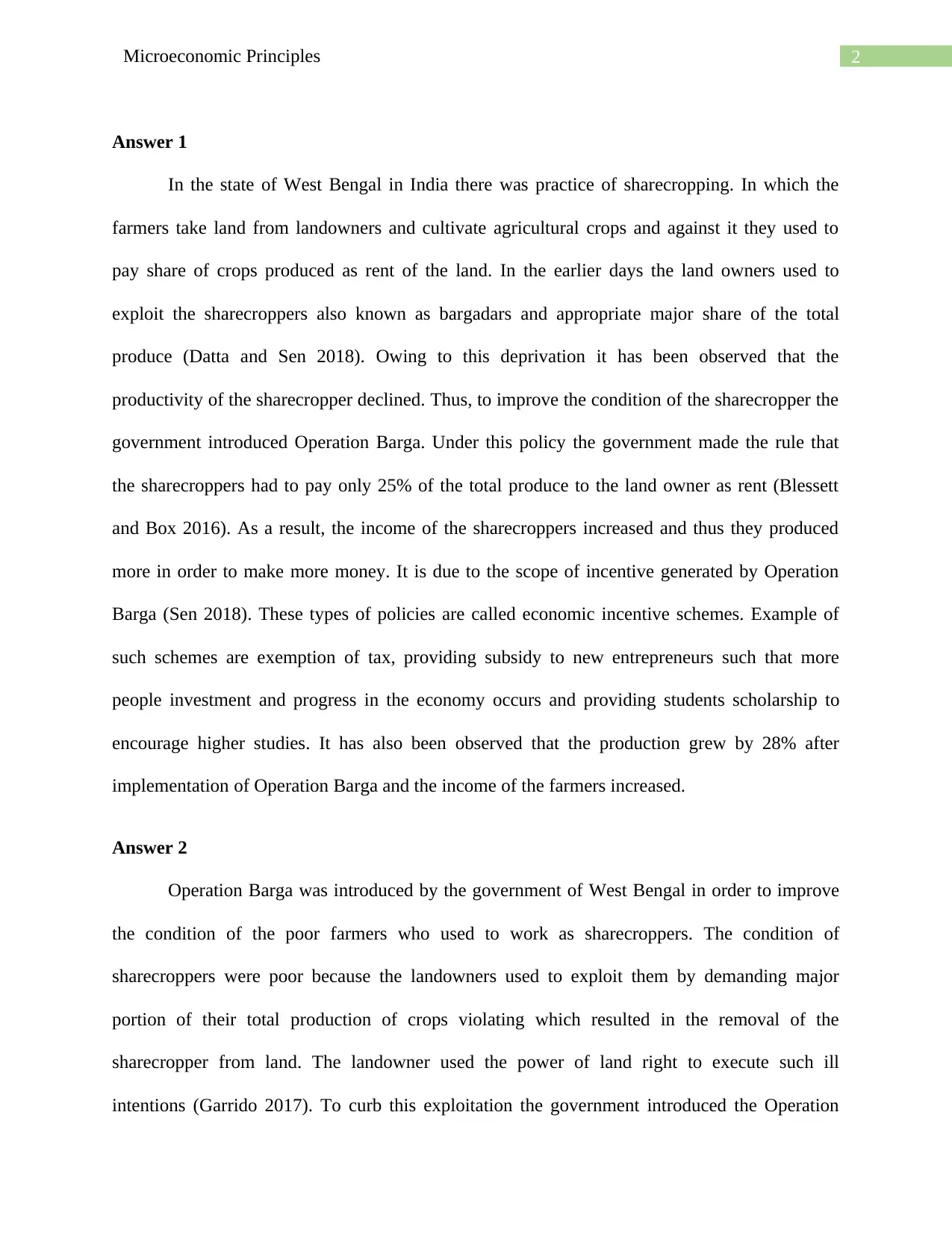
2Microeconomic Principles
Answer 1
In the state of West Bengal in India there was practice of sharecropping. In which the
farmers take land from landowners and cultivate agricultural crops and against it they used to
pay share of crops produced as rent of the land. In the earlier days the land owners used to
exploit the sharecroppers also known as bargadars and appropriate major share of the total
produce (Datta and Sen 2018). Owing to this deprivation it has been observed that the
productivity of the sharecropper declined. Thus, to improve the condition of the sharecropper the
government introduced Operation Barga. Under this policy the government made the rule that
the sharecroppers had to pay only 25% of the total produce to the land owner as rent (Blessett
and Box 2016). As a result, the income of the sharecroppers increased and thus they produced
more in order to make more money. It is due to the scope of incentive generated by Operation
Barga (Sen 2018). These types of policies are called economic incentive schemes. Example of
such schemes are exemption of tax, providing subsidy to new entrepreneurs such that more
people investment and progress in the economy occurs and providing students scholarship to
encourage higher studies. It has also been observed that the production grew by 28% after
implementation of Operation Barga and the income of the farmers increased.
Answer 2
Operation Barga was introduced by the government of West Bengal in order to improve
the condition of the poor farmers who used to work as sharecroppers. The condition of
sharecroppers were poor because the landowners used to exploit them by demanding major
portion of their total production of crops violating which resulted in the removal of the
sharecropper from land. The landowner used the power of land right to execute such ill
intentions (Garrido 2017). To curb this exploitation the government introduced the Operation
Answer 1
In the state of West Bengal in India there was practice of sharecropping. In which the
farmers take land from landowners and cultivate agricultural crops and against it they used to
pay share of crops produced as rent of the land. In the earlier days the land owners used to
exploit the sharecroppers also known as bargadars and appropriate major share of the total
produce (Datta and Sen 2018). Owing to this deprivation it has been observed that the
productivity of the sharecropper declined. Thus, to improve the condition of the sharecropper the
government introduced Operation Barga. Under this policy the government made the rule that
the sharecroppers had to pay only 25% of the total produce to the land owner as rent (Blessett
and Box 2016). As a result, the income of the sharecroppers increased and thus they produced
more in order to make more money. It is due to the scope of incentive generated by Operation
Barga (Sen 2018). These types of policies are called economic incentive schemes. Example of
such schemes are exemption of tax, providing subsidy to new entrepreneurs such that more
people investment and progress in the economy occurs and providing students scholarship to
encourage higher studies. It has also been observed that the production grew by 28% after
implementation of Operation Barga and the income of the farmers increased.
Answer 2
Operation Barga was introduced by the government of West Bengal in order to improve
the condition of the poor farmers who used to work as sharecroppers. The condition of
sharecroppers were poor because the landowners used to exploit them by demanding major
portion of their total production of crops violating which resulted in the removal of the
sharecropper from land. The landowner used the power of land right to execute such ill
intentions (Garrido 2017). To curb this exploitation the government introduced the Operation
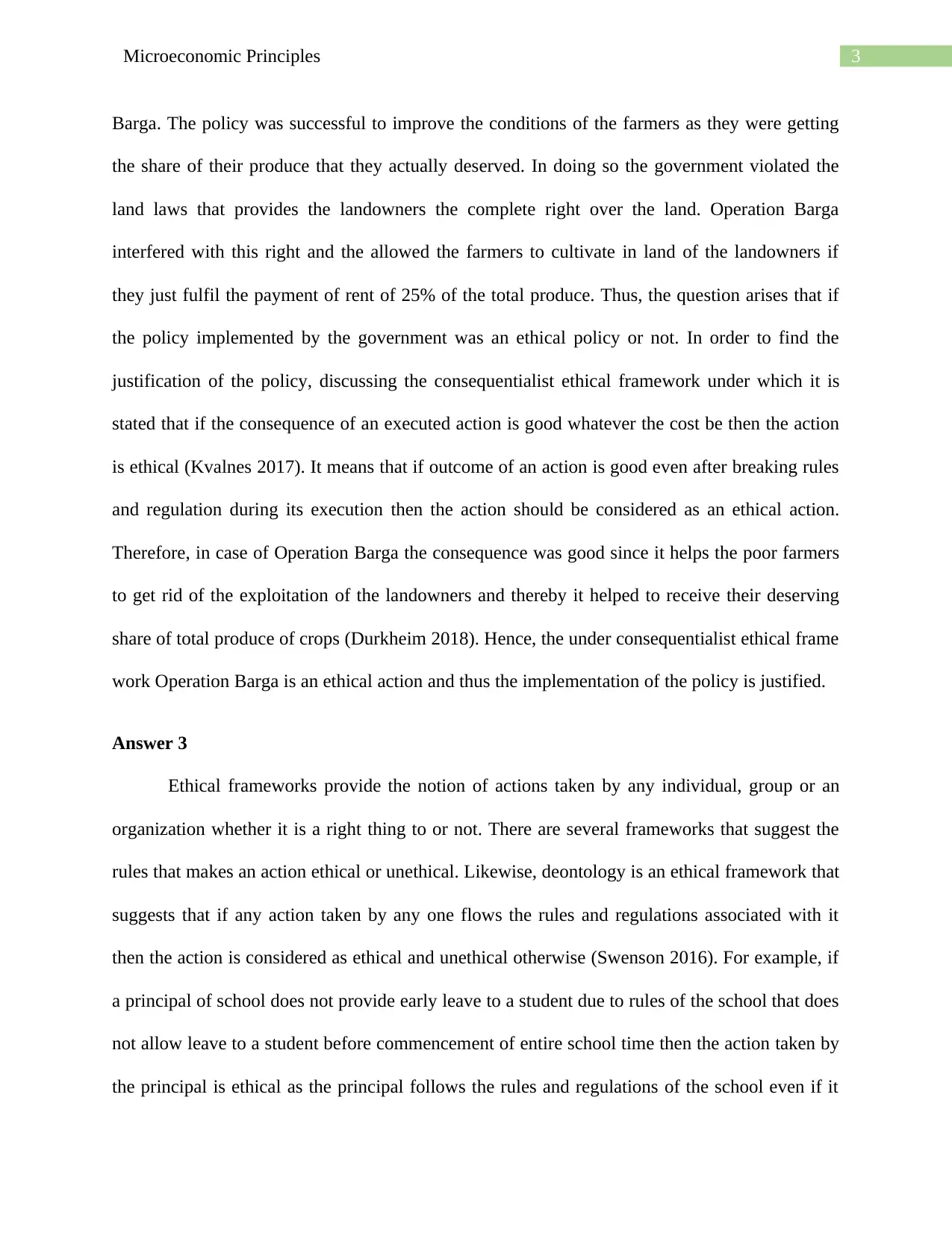
3Microeconomic Principles
Barga. The policy was successful to improve the conditions of the farmers as they were getting
the share of their produce that they actually deserved. In doing so the government violated the
land laws that provides the landowners the complete right over the land. Operation Barga
interfered with this right and the allowed the farmers to cultivate in land of the landowners if
they just fulfil the payment of rent of 25% of the total produce. Thus, the question arises that if
the policy implemented by the government was an ethical policy or not. In order to find the
justification of the policy, discussing the consequentialist ethical framework under which it is
stated that if the consequence of an executed action is good whatever the cost be then the action
is ethical (Kvalnes 2017). It means that if outcome of an action is good even after breaking rules
and regulation during its execution then the action should be considered as an ethical action.
Therefore, in case of Operation Barga the consequence was good since it helps the poor farmers
to get rid of the exploitation of the landowners and thereby it helped to receive their deserving
share of total produce of crops (Durkheim 2018). Hence, the under consequentialist ethical frame
work Operation Barga is an ethical action and thus the implementation of the policy is justified.
Answer 3
Ethical frameworks provide the notion of actions taken by any individual, group or an
organization whether it is a right thing to or not. There are several frameworks that suggest the
rules that makes an action ethical or unethical. Likewise, deontology is an ethical framework that
suggests that if any action taken by any one flows the rules and regulations associated with it
then the action is considered as ethical and unethical otherwise (Swenson 2016). For example, if
a principal of school does not provide early leave to a student due to rules of the school that does
not allow leave to a student before commencement of entire school time then the action taken by
the principal is ethical as the principal follows the rules and regulations of the school even if it
Barga. The policy was successful to improve the conditions of the farmers as they were getting
the share of their produce that they actually deserved. In doing so the government violated the
land laws that provides the landowners the complete right over the land. Operation Barga
interfered with this right and the allowed the farmers to cultivate in land of the landowners if
they just fulfil the payment of rent of 25% of the total produce. Thus, the question arises that if
the policy implemented by the government was an ethical policy or not. In order to find the
justification of the policy, discussing the consequentialist ethical framework under which it is
stated that if the consequence of an executed action is good whatever the cost be then the action
is ethical (Kvalnes 2017). It means that if outcome of an action is good even after breaking rules
and regulation during its execution then the action should be considered as an ethical action.
Therefore, in case of Operation Barga the consequence was good since it helps the poor farmers
to get rid of the exploitation of the landowners and thereby it helped to receive their deserving
share of total produce of crops (Durkheim 2018). Hence, the under consequentialist ethical frame
work Operation Barga is an ethical action and thus the implementation of the policy is justified.
Answer 3
Ethical frameworks provide the notion of actions taken by any individual, group or an
organization whether it is a right thing to or not. There are several frameworks that suggest the
rules that makes an action ethical or unethical. Likewise, deontology is an ethical framework that
suggests that if any action taken by any one flows the rules and regulations associated with it
then the action is considered as ethical and unethical otherwise (Swenson 2016). For example, if
a principal of school does not provide early leave to a student due to rules of the school that does
not allow leave to a student before commencement of entire school time then the action taken by
the principal is ethical as the principal follows the rules and regulations of the school even if it
Secure Best Marks with AI Grader
Need help grading? Try our AI Grader for instant feedback on your assignments.
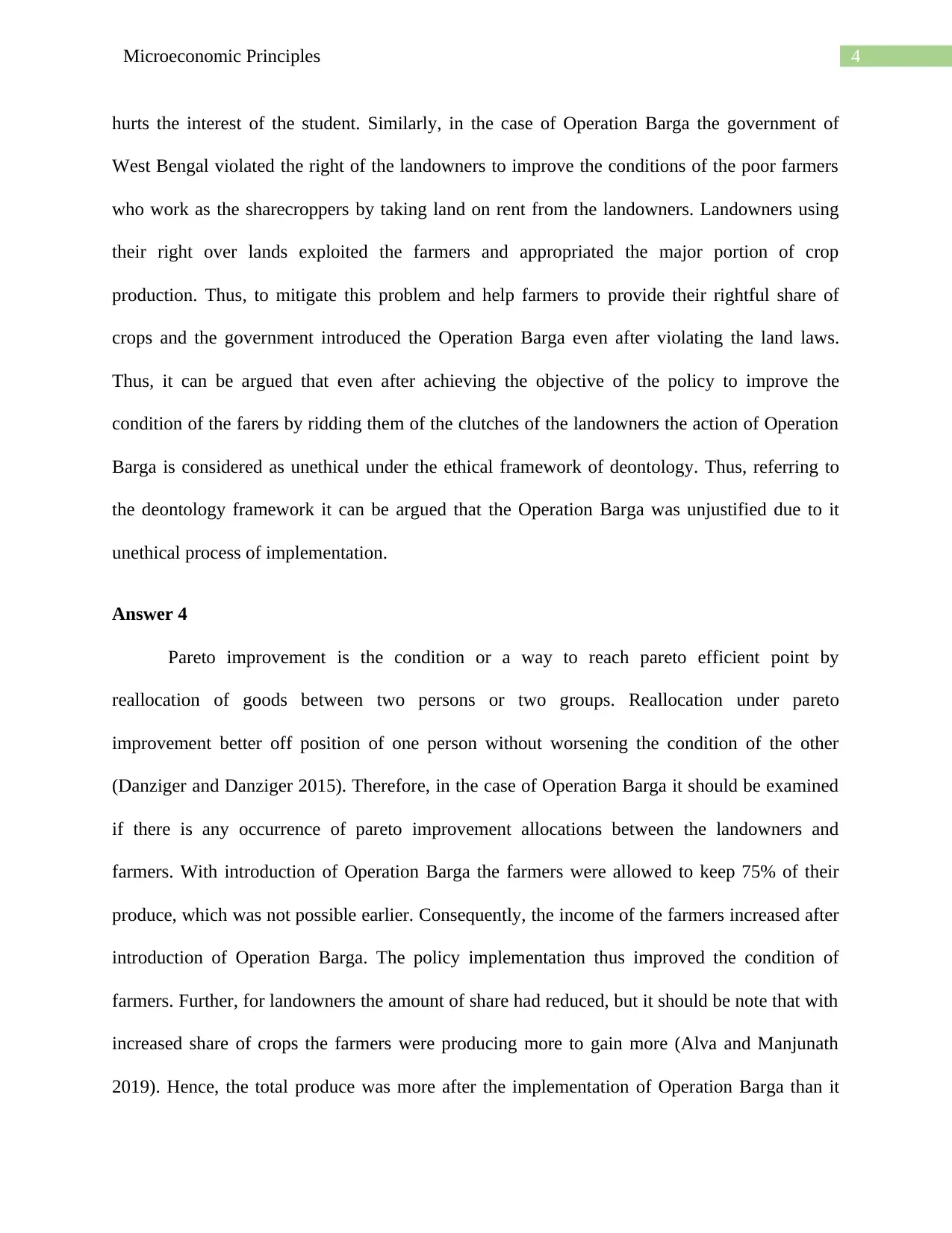
4Microeconomic Principles
hurts the interest of the student. Similarly, in the case of Operation Barga the government of
West Bengal violated the right of the landowners to improve the conditions of the poor farmers
who work as the sharecroppers by taking land on rent from the landowners. Landowners using
their right over lands exploited the farmers and appropriated the major portion of crop
production. Thus, to mitigate this problem and help farmers to provide their rightful share of
crops and the government introduced the Operation Barga even after violating the land laws.
Thus, it can be argued that even after achieving the objective of the policy to improve the
condition of the farers by ridding them of the clutches of the landowners the action of Operation
Barga is considered as unethical under the ethical framework of deontology. Thus, referring to
the deontology framework it can be argued that the Operation Barga was unjustified due to it
unethical process of implementation.
Answer 4
Pareto improvement is the condition or a way to reach pareto efficient point by
reallocation of goods between two persons or two groups. Reallocation under pareto
improvement better off position of one person without worsening the condition of the other
(Danziger and Danziger 2015). Therefore, in the case of Operation Barga it should be examined
if there is any occurrence of pareto improvement allocations between the landowners and
farmers. With introduction of Operation Barga the farmers were allowed to keep 75% of their
produce, which was not possible earlier. Consequently, the income of the farmers increased after
introduction of Operation Barga. The policy implementation thus improved the condition of
farmers. Further, for landowners the amount of share had reduced, but it should be note that with
increased share of crops the farmers were producing more to gain more (Alva and Manjunath
2019). Hence, the total produce was more after the implementation of Operation Barga than it
hurts the interest of the student. Similarly, in the case of Operation Barga the government of
West Bengal violated the right of the landowners to improve the conditions of the poor farmers
who work as the sharecroppers by taking land on rent from the landowners. Landowners using
their right over lands exploited the farmers and appropriated the major portion of crop
production. Thus, to mitigate this problem and help farmers to provide their rightful share of
crops and the government introduced the Operation Barga even after violating the land laws.
Thus, it can be argued that even after achieving the objective of the policy to improve the
condition of the farers by ridding them of the clutches of the landowners the action of Operation
Barga is considered as unethical under the ethical framework of deontology. Thus, referring to
the deontology framework it can be argued that the Operation Barga was unjustified due to it
unethical process of implementation.
Answer 4
Pareto improvement is the condition or a way to reach pareto efficient point by
reallocation of goods between two persons or two groups. Reallocation under pareto
improvement better off position of one person without worsening the condition of the other
(Danziger and Danziger 2015). Therefore, in the case of Operation Barga it should be examined
if there is any occurrence of pareto improvement allocations between the landowners and
farmers. With introduction of Operation Barga the farmers were allowed to keep 75% of their
produce, which was not possible earlier. Consequently, the income of the farmers increased after
introduction of Operation Barga. The policy implementation thus improved the condition of
farmers. Further, for landowners the amount of share had reduced, but it should be note that with
increased share of crops the farmers were producing more to gain more (Alva and Manjunath
2019). Hence, the total produce was more after the implementation of Operation Barga than it
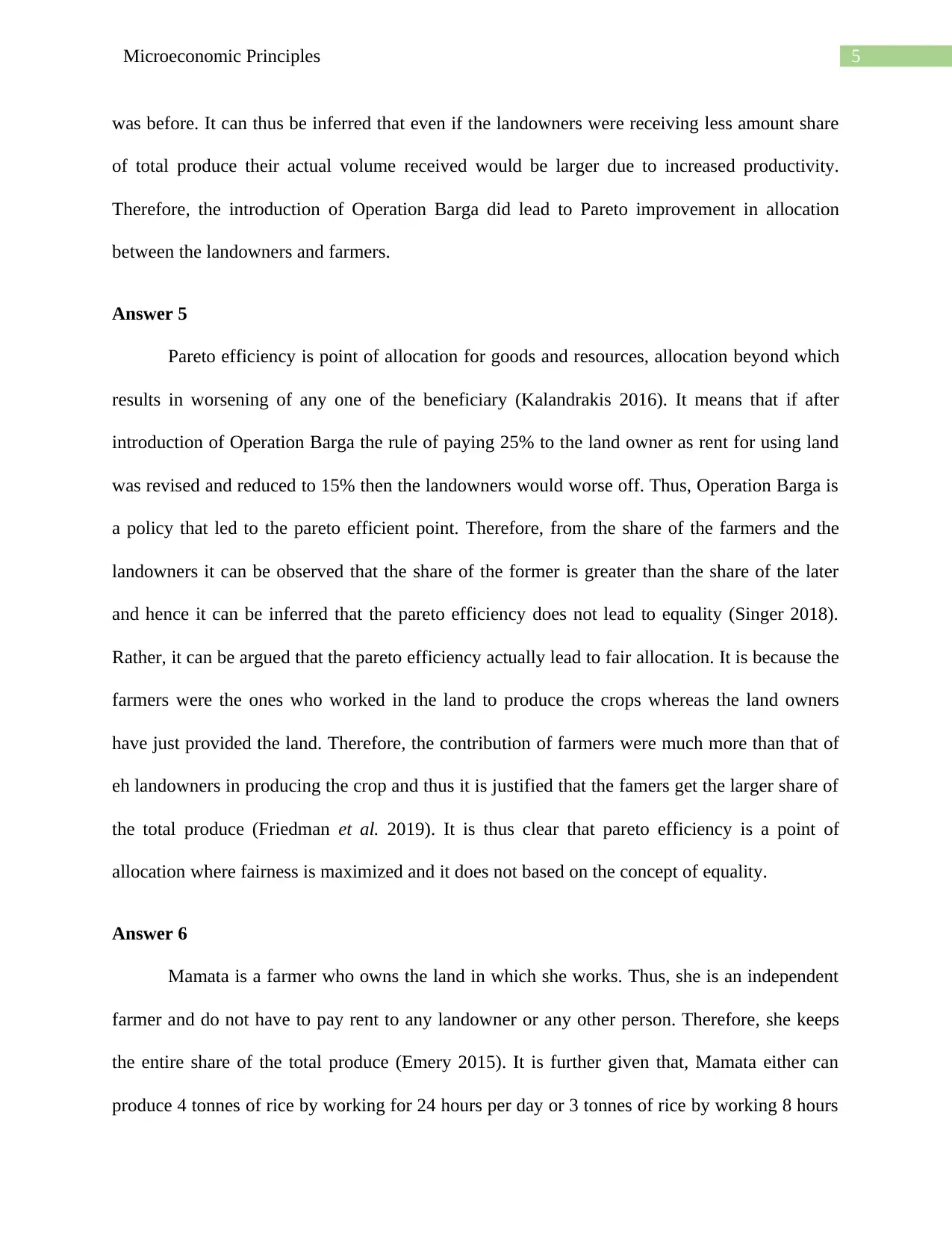
5Microeconomic Principles
was before. It can thus be inferred that even if the landowners were receiving less amount share
of total produce their actual volume received would be larger due to increased productivity.
Therefore, the introduction of Operation Barga did lead to Pareto improvement in allocation
between the landowners and farmers.
Answer 5
Pareto efficiency is point of allocation for goods and resources, allocation beyond which
results in worsening of any one of the beneficiary (Kalandrakis 2016). It means that if after
introduction of Operation Barga the rule of paying 25% to the land owner as rent for using land
was revised and reduced to 15% then the landowners would worse off. Thus, Operation Barga is
a policy that led to the pareto efficient point. Therefore, from the share of the farmers and the
landowners it can be observed that the share of the former is greater than the share of the later
and hence it can be inferred that the pareto efficiency does not lead to equality (Singer 2018).
Rather, it can be argued that the pareto efficiency actually lead to fair allocation. It is because the
farmers were the ones who worked in the land to produce the crops whereas the land owners
have just provided the land. Therefore, the contribution of farmers were much more than that of
eh landowners in producing the crop and thus it is justified that the famers get the larger share of
the total produce (Friedman et al. 2019). It is thus clear that pareto efficiency is a point of
allocation where fairness is maximized and it does not based on the concept of equality.
Answer 6
Mamata is a farmer who owns the land in which she works. Thus, she is an independent
farmer and do not have to pay rent to any landowner or any other person. Therefore, she keeps
the entire share of the total produce (Emery 2015). It is further given that, Mamata either can
produce 4 tonnes of rice by working for 24 hours per day or 3 tonnes of rice by working 8 hours
was before. It can thus be inferred that even if the landowners were receiving less amount share
of total produce their actual volume received would be larger due to increased productivity.
Therefore, the introduction of Operation Barga did lead to Pareto improvement in allocation
between the landowners and farmers.
Answer 5
Pareto efficiency is point of allocation for goods and resources, allocation beyond which
results in worsening of any one of the beneficiary (Kalandrakis 2016). It means that if after
introduction of Operation Barga the rule of paying 25% to the land owner as rent for using land
was revised and reduced to 15% then the landowners would worse off. Thus, Operation Barga is
a policy that led to the pareto efficient point. Therefore, from the share of the farmers and the
landowners it can be observed that the share of the former is greater than the share of the later
and hence it can be inferred that the pareto efficiency does not lead to equality (Singer 2018).
Rather, it can be argued that the pareto efficiency actually lead to fair allocation. It is because the
farmers were the ones who worked in the land to produce the crops whereas the land owners
have just provided the land. Therefore, the contribution of farmers were much more than that of
eh landowners in producing the crop and thus it is justified that the famers get the larger share of
the total produce (Friedman et al. 2019). It is thus clear that pareto efficiency is a point of
allocation where fairness is maximized and it does not based on the concept of equality.
Answer 6
Mamata is a farmer who owns the land in which she works. Thus, she is an independent
farmer and do not have to pay rent to any landowner or any other person. Therefore, she keeps
the entire share of the total produce (Emery 2015). It is further given that, Mamata either can
produce 4 tonnes of rice by working for 24 hours per day or 3 tonnes of rice by working 8 hours
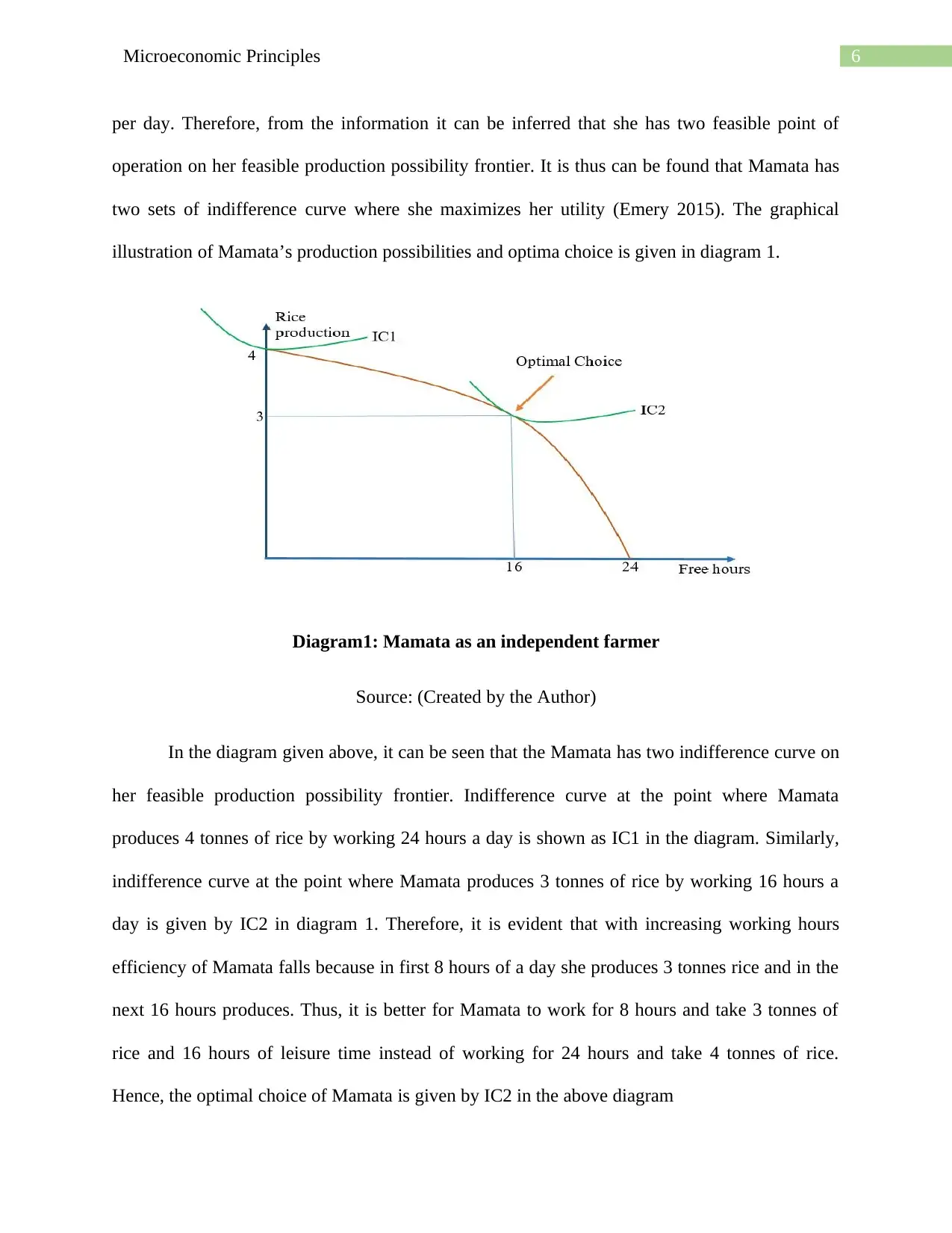
6Microeconomic Principles
per day. Therefore, from the information it can be inferred that she has two feasible point of
operation on her feasible production possibility frontier. It is thus can be found that Mamata has
two sets of indifference curve where she maximizes her utility (Emery 2015). The graphical
illustration of Mamata’s production possibilities and optima choice is given in diagram 1.
Diagram1: Mamata as an independent farmer
Source: (Created by the Author)
In the diagram given above, it can be seen that the Mamata has two indifference curve on
her feasible production possibility frontier. Indifference curve at the point where Mamata
produces 4 tonnes of rice by working 24 hours a day is shown as IC1 in the diagram. Similarly,
indifference curve at the point where Mamata produces 3 tonnes of rice by working 16 hours a
day is given by IC2 in diagram 1. Therefore, it is evident that with increasing working hours
efficiency of Mamata falls because in first 8 hours of a day she produces 3 tonnes rice and in the
next 16 hours produces. Thus, it is better for Mamata to work for 8 hours and take 3 tonnes of
rice and 16 hours of leisure time instead of working for 24 hours and take 4 tonnes of rice.
Hence, the optimal choice of Mamata is given by IC2 in the above diagram
per day. Therefore, from the information it can be inferred that she has two feasible point of
operation on her feasible production possibility frontier. It is thus can be found that Mamata has
two sets of indifference curve where she maximizes her utility (Emery 2015). The graphical
illustration of Mamata’s production possibilities and optima choice is given in diagram 1.
Diagram1: Mamata as an independent farmer
Source: (Created by the Author)
In the diagram given above, it can be seen that the Mamata has two indifference curve on
her feasible production possibility frontier. Indifference curve at the point where Mamata
produces 4 tonnes of rice by working 24 hours a day is shown as IC1 in the diagram. Similarly,
indifference curve at the point where Mamata produces 3 tonnes of rice by working 16 hours a
day is given by IC2 in diagram 1. Therefore, it is evident that with increasing working hours
efficiency of Mamata falls because in first 8 hours of a day she produces 3 tonnes rice and in the
next 16 hours produces. Thus, it is better for Mamata to work for 8 hours and take 3 tonnes of
rice and 16 hours of leisure time instead of working for 24 hours and take 4 tonnes of rice.
Hence, the optimal choice of Mamata is given by IC2 in the above diagram
Paraphrase This Document
Need a fresh take? Get an instant paraphrase of this document with our AI Paraphraser
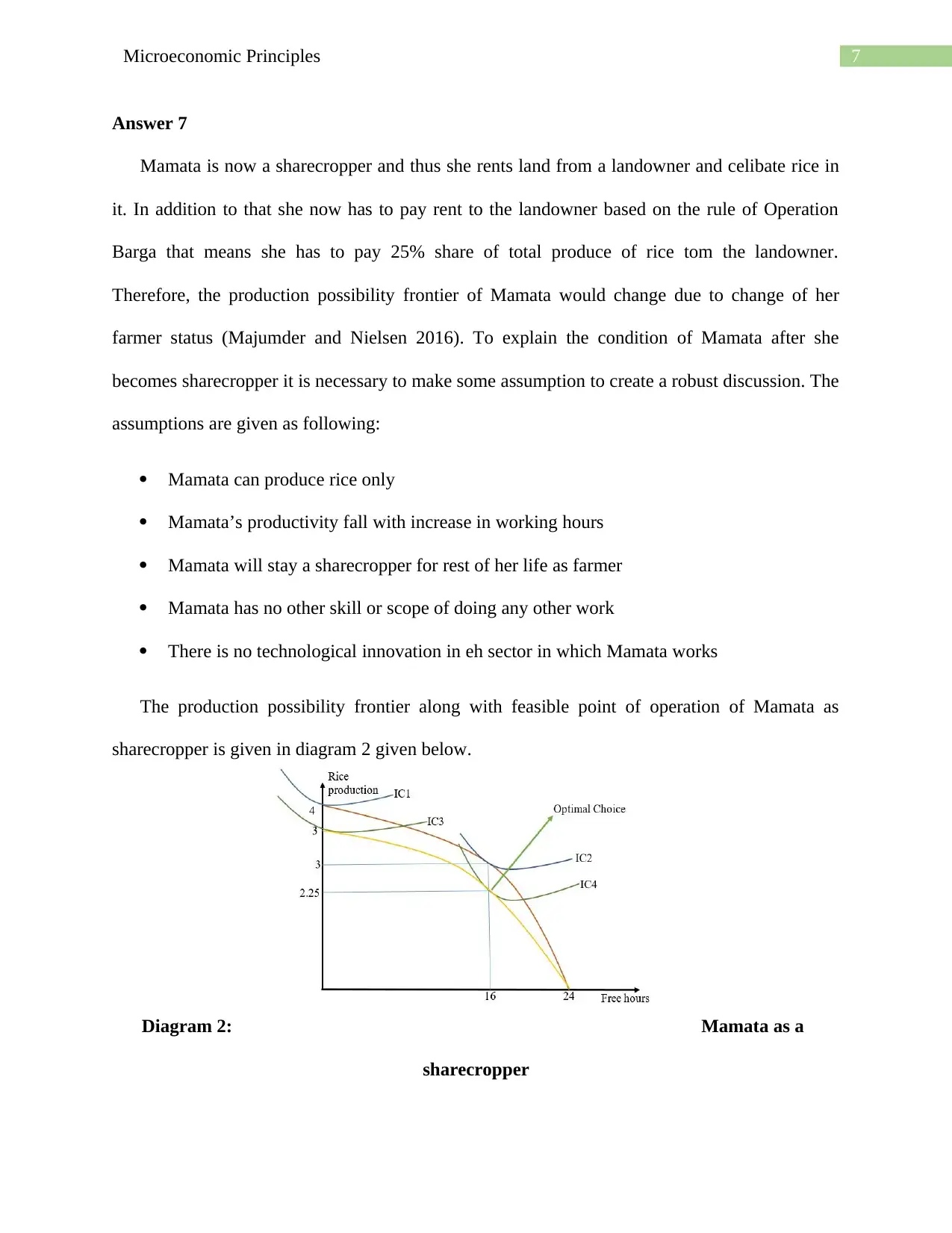
7Microeconomic Principles
Answer 7
Mamata is now a sharecropper and thus she rents land from a landowner and celibate rice in
it. In addition to that she now has to pay rent to the landowner based on the rule of Operation
Barga that means she has to pay 25% share of total produce of rice tom the landowner.
Therefore, the production possibility frontier of Mamata would change due to change of her
farmer status (Majumder and Nielsen 2016). To explain the condition of Mamata after she
becomes sharecropper it is necessary to make some assumption to create a robust discussion. The
assumptions are given as following:
Mamata can produce rice only
Mamata’s productivity fall with increase in working hours
Mamata will stay a sharecropper for rest of her life as farmer
Mamata has no other skill or scope of doing any other work
There is no technological innovation in eh sector in which Mamata works
The production possibility frontier along with feasible point of operation of Mamata as
sharecropper is given in diagram 2 given below.
Diagram 2: Mamata as a
sharecropper
Answer 7
Mamata is now a sharecropper and thus she rents land from a landowner and celibate rice in
it. In addition to that she now has to pay rent to the landowner based on the rule of Operation
Barga that means she has to pay 25% share of total produce of rice tom the landowner.
Therefore, the production possibility frontier of Mamata would change due to change of her
farmer status (Majumder and Nielsen 2016). To explain the condition of Mamata after she
becomes sharecropper it is necessary to make some assumption to create a robust discussion. The
assumptions are given as following:
Mamata can produce rice only
Mamata’s productivity fall with increase in working hours
Mamata will stay a sharecropper for rest of her life as farmer
Mamata has no other skill or scope of doing any other work
There is no technological innovation in eh sector in which Mamata works
The production possibility frontier along with feasible point of operation of Mamata as
sharecropper is given in diagram 2 given below.
Diagram 2: Mamata as a
sharecropper
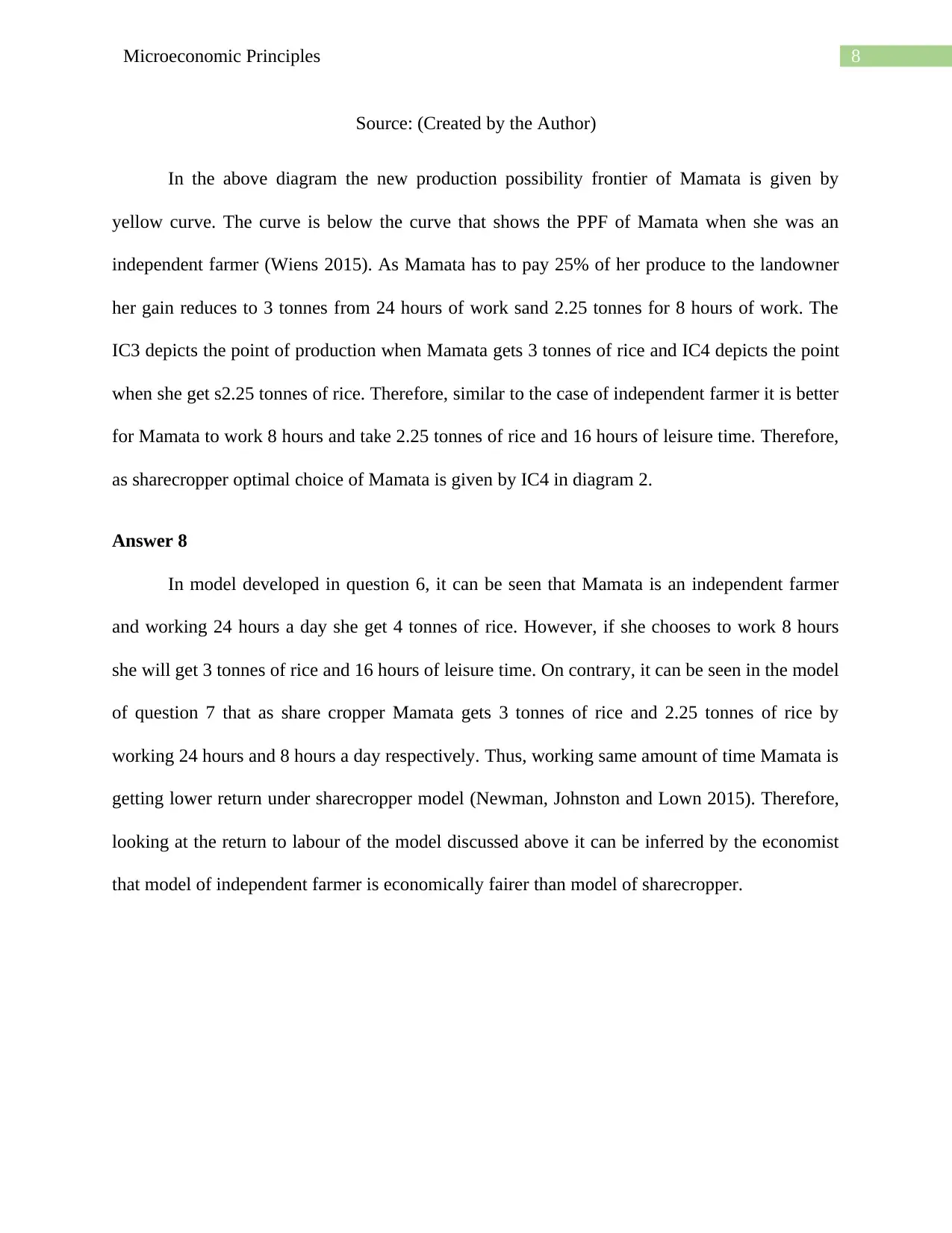
8Microeconomic Principles
Source: (Created by the Author)
In the above diagram the new production possibility frontier of Mamata is given by
yellow curve. The curve is below the curve that shows the PPF of Mamata when she was an
independent farmer (Wiens 2015). As Mamata has to pay 25% of her produce to the landowner
her gain reduces to 3 tonnes from 24 hours of work sand 2.25 tonnes for 8 hours of work. The
IC3 depicts the point of production when Mamata gets 3 tonnes of rice and IC4 depicts the point
when she get s2.25 tonnes of rice. Therefore, similar to the case of independent farmer it is better
for Mamata to work 8 hours and take 2.25 tonnes of rice and 16 hours of leisure time. Therefore,
as sharecropper optimal choice of Mamata is given by IC4 in diagram 2.
Answer 8
In model developed in question 6, it can be seen that Mamata is an independent farmer
and working 24 hours a day she get 4 tonnes of rice. However, if she chooses to work 8 hours
she will get 3 tonnes of rice and 16 hours of leisure time. On contrary, it can be seen in the model
of question 7 that as share cropper Mamata gets 3 tonnes of rice and 2.25 tonnes of rice by
working 24 hours and 8 hours a day respectively. Thus, working same amount of time Mamata is
getting lower return under sharecropper model (Newman, Johnston and Lown 2015). Therefore,
looking at the return to labour of the model discussed above it can be inferred by the economist
that model of independent farmer is economically fairer than model of sharecropper.
Source: (Created by the Author)
In the above diagram the new production possibility frontier of Mamata is given by
yellow curve. The curve is below the curve that shows the PPF of Mamata when she was an
independent farmer (Wiens 2015). As Mamata has to pay 25% of her produce to the landowner
her gain reduces to 3 tonnes from 24 hours of work sand 2.25 tonnes for 8 hours of work. The
IC3 depicts the point of production when Mamata gets 3 tonnes of rice and IC4 depicts the point
when she get s2.25 tonnes of rice. Therefore, similar to the case of independent farmer it is better
for Mamata to work 8 hours and take 2.25 tonnes of rice and 16 hours of leisure time. Therefore,
as sharecropper optimal choice of Mamata is given by IC4 in diagram 2.
Answer 8
In model developed in question 6, it can be seen that Mamata is an independent farmer
and working 24 hours a day she get 4 tonnes of rice. However, if she chooses to work 8 hours
she will get 3 tonnes of rice and 16 hours of leisure time. On contrary, it can be seen in the model
of question 7 that as share cropper Mamata gets 3 tonnes of rice and 2.25 tonnes of rice by
working 24 hours and 8 hours a day respectively. Thus, working same amount of time Mamata is
getting lower return under sharecropper model (Newman, Johnston and Lown 2015). Therefore,
looking at the return to labour of the model discussed above it can be inferred by the economist
that model of independent farmer is economically fairer than model of sharecropper.
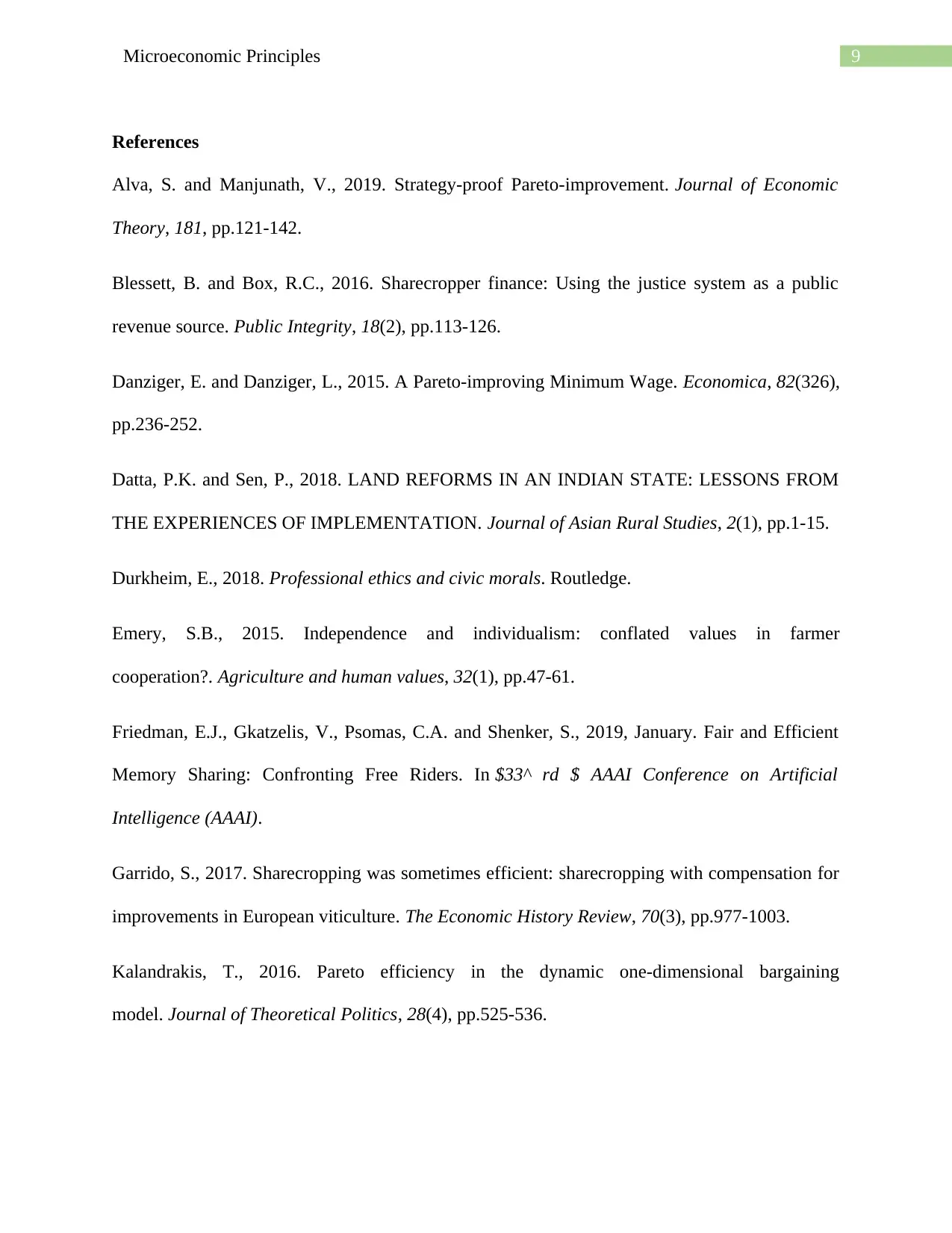
9Microeconomic Principles
References
Alva, S. and Manjunath, V., 2019. Strategy-proof Pareto-improvement. Journal of Economic
Theory, 181, pp.121-142.
Blessett, B. and Box, R.C., 2016. Sharecropper finance: Using the justice system as a public
revenue source. Public Integrity, 18(2), pp.113-126.
Danziger, E. and Danziger, L., 2015. A Pareto‐improving Minimum Wage. Economica, 82(326),
pp.236-252.
Datta, P.K. and Sen, P., 2018. LAND REFORMS IN AN INDIAN STATE: LESSONS FROM
THE EXPERIENCES OF IMPLEMENTATION. Journal of Asian Rural Studies, 2(1), pp.1-15.
Durkheim, E., 2018. Professional ethics and civic morals. Routledge.
Emery, S.B., 2015. Independence and individualism: conflated values in farmer
cooperation?. Agriculture and human values, 32(1), pp.47-61.
Friedman, E.J., Gkatzelis, V., Psomas, C.A. and Shenker, S., 2019, January. Fair and Efficient
Memory Sharing: Confronting Free Riders. In $33^ rd $ AAAI Conference on Artificial
Intelligence (AAAI).
Garrido, S., 2017. Sharecropping was sometimes efficient: sharecropping with compensation for
improvements in European viticulture. The Economic History Review, 70(3), pp.977-1003.
Kalandrakis, T., 2016. Pareto efficiency in the dynamic one-dimensional bargaining
model. Journal of Theoretical Politics, 28(4), pp.525-536.
References
Alva, S. and Manjunath, V., 2019. Strategy-proof Pareto-improvement. Journal of Economic
Theory, 181, pp.121-142.
Blessett, B. and Box, R.C., 2016. Sharecropper finance: Using the justice system as a public
revenue source. Public Integrity, 18(2), pp.113-126.
Danziger, E. and Danziger, L., 2015. A Pareto‐improving Minimum Wage. Economica, 82(326),
pp.236-252.
Datta, P.K. and Sen, P., 2018. LAND REFORMS IN AN INDIAN STATE: LESSONS FROM
THE EXPERIENCES OF IMPLEMENTATION. Journal of Asian Rural Studies, 2(1), pp.1-15.
Durkheim, E., 2018. Professional ethics and civic morals. Routledge.
Emery, S.B., 2015. Independence and individualism: conflated values in farmer
cooperation?. Agriculture and human values, 32(1), pp.47-61.
Friedman, E.J., Gkatzelis, V., Psomas, C.A. and Shenker, S., 2019, January. Fair and Efficient
Memory Sharing: Confronting Free Riders. In $33^ rd $ AAAI Conference on Artificial
Intelligence (AAAI).
Garrido, S., 2017. Sharecropping was sometimes efficient: sharecropping with compensation for
improvements in European viticulture. The Economic History Review, 70(3), pp.977-1003.
Kalandrakis, T., 2016. Pareto efficiency in the dynamic one-dimensional bargaining
model. Journal of Theoretical Politics, 28(4), pp.525-536.
Secure Best Marks with AI Grader
Need help grading? Try our AI Grader for instant feedback on your assignments.
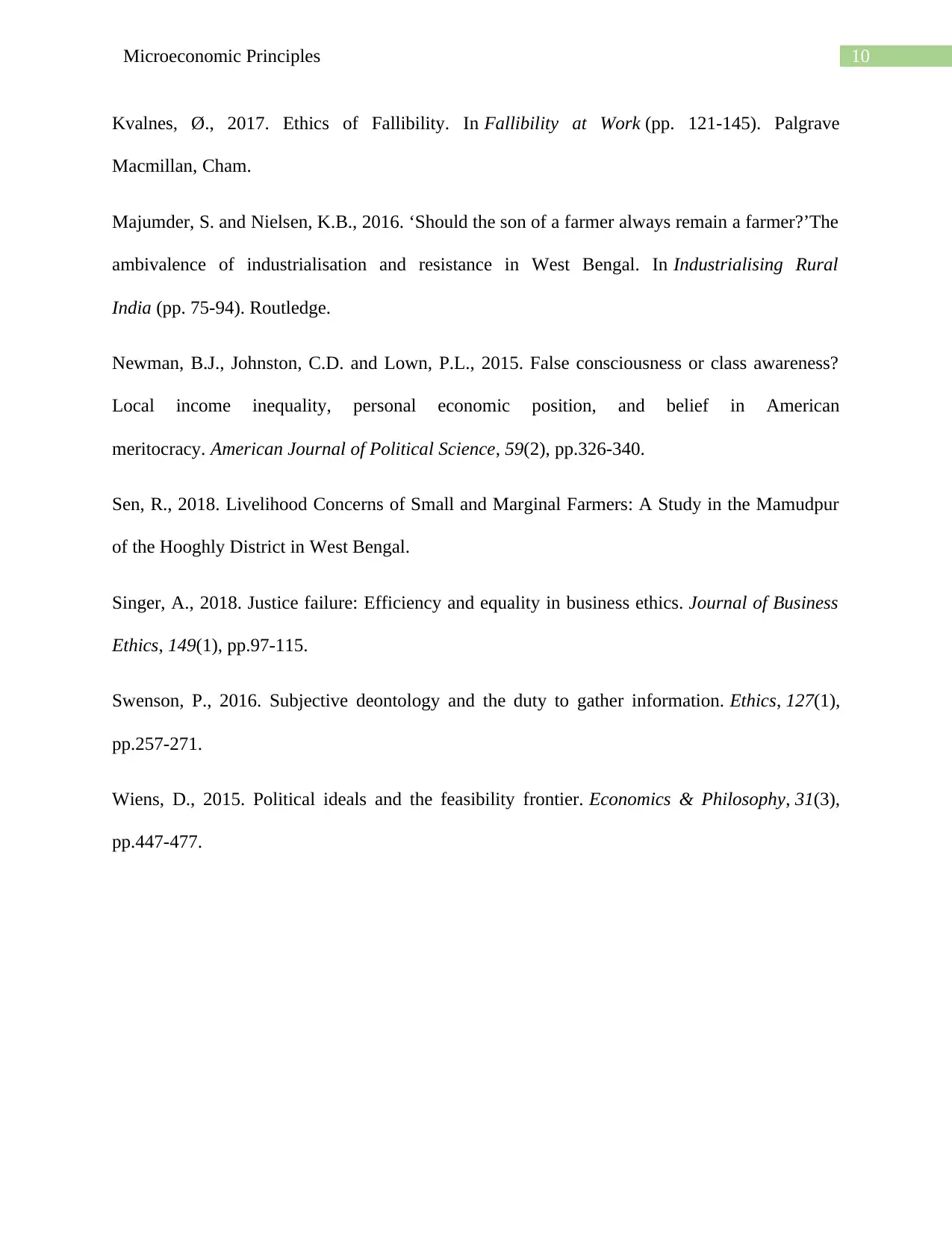
10Microeconomic Principles
Kvalnes, Ø., 2017. Ethics of Fallibility. In Fallibility at Work (pp. 121-145). Palgrave
Macmillan, Cham.
Majumder, S. and Nielsen, K.B., 2016. ‘Should the son of a farmer always remain a farmer?’The
ambivalence of industrialisation and resistance in West Bengal. In Industrialising Rural
India (pp. 75-94). Routledge.
Newman, B.J., Johnston, C.D. and Lown, P.L., 2015. False consciousness or class awareness?
Local income inequality, personal economic position, and belief in American
meritocracy. American Journal of Political Science, 59(2), pp.326-340.
Sen, R., 2018. Livelihood Concerns of Small and Marginal Farmers: A Study in the Mamudpur
of the Hooghly District in West Bengal.
Singer, A., 2018. Justice failure: Efficiency and equality in business ethics. Journal of Business
Ethics, 149(1), pp.97-115.
Swenson, P., 2016. Subjective deontology and the duty to gather information. Ethics, 127(1),
pp.257-271.
Wiens, D., 2015. Political ideals and the feasibility frontier. Economics & Philosophy, 31(3),
pp.447-477.
Kvalnes, Ø., 2017. Ethics of Fallibility. In Fallibility at Work (pp. 121-145). Palgrave
Macmillan, Cham.
Majumder, S. and Nielsen, K.B., 2016. ‘Should the son of a farmer always remain a farmer?’The
ambivalence of industrialisation and resistance in West Bengal. In Industrialising Rural
India (pp. 75-94). Routledge.
Newman, B.J., Johnston, C.D. and Lown, P.L., 2015. False consciousness or class awareness?
Local income inequality, personal economic position, and belief in American
meritocracy. American Journal of Political Science, 59(2), pp.326-340.
Sen, R., 2018. Livelihood Concerns of Small and Marginal Farmers: A Study in the Mamudpur
of the Hooghly District in West Bengal.
Singer, A., 2018. Justice failure: Efficiency and equality in business ethics. Journal of Business
Ethics, 149(1), pp.97-115.
Swenson, P., 2016. Subjective deontology and the duty to gather information. Ethics, 127(1),
pp.257-271.
Wiens, D., 2015. Political ideals and the feasibility frontier. Economics & Philosophy, 31(3),
pp.447-477.
1 out of 11
Related Documents
Your All-in-One AI-Powered Toolkit for Academic Success.
+13062052269
info@desklib.com
Available 24*7 on WhatsApp / Email
![[object Object]](/_next/static/media/star-bottom.7253800d.svg)
Unlock your academic potential
© 2024 | Zucol Services PVT LTD | All rights reserved.





